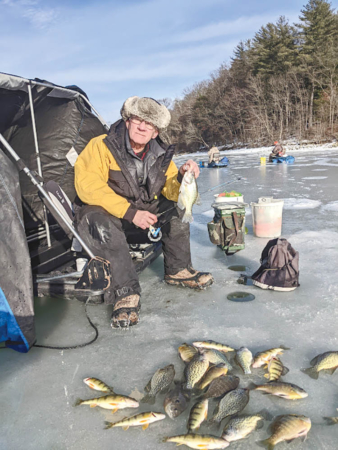When I wrote the article that appeared in last week’s column, I was just about to head out for my first ice fishing outing of the new season. It was, in fact, the first time in some years that we were able to get safely on the ice before the new year. As you can see in the photo accompanying this piece, the fishing was pretty good — fairly steady action all afternoon, and it appeared others were also experiencing some decent catches. This warm, rainy period may keep us off the lakes for a time, but hopefully, we can get back out again soon.
One of the questions I often get from those who are not a part of the “frozen chosen” is, what do you use to get that bunch of panfish that we see in the photograph? After giving that question some thought, I realized that there were two very different approaches depending on the time of year. I think most ice fishermen would be quick to tell you that having some form of live bait is essential to record good catch rates. Certainly, other factors contribute to success but having some form of live bait on hand is almost a must when fishing the hard water. While most of us use a small (one-eighth or one-sixteenth-ounce) artificial jig, we are also very quick to attach some form of live bait to the presentation.
So what bait is likely to be utilized? Some very popular choices are wax worms, mealworms and butter worms, and of course, live minnows.
Now I’m talking panfishing here, so If I’m using minnows, I want to keep them small enough so the fish I’m after can get the bait into their mouth. Bluegills have small mouths, so unless it’s a large bluegill, a minnow may not be a good choice. Perch and crappies have larger mouths, especially crappies, so minnows may work well. Wax, meal, and butter worms are generally good choices for all three of the above-mentioned panfish. Unfortunately, bait like wax worms and meal worms are not always available at your local tackle store.
A bait I didn’t mention at the beginning of this paragraph and one that is often overlooked during the ice fishing season is the common earthworm or night crawlers. Last week when I headed out, I stopped for bait and found the only thing available at the time was night crawlers. My buddy Tim had a good supply of ‘waxies,’ but I decided to pick up some crawlers as well. I fished crawlers on my jigs, and he fished wax worms on his, but in the end, we both did well. If you do use night crawlers, it’s important to break off a small half-inch or so pieces to place on your small jig; remember, a lot of the fish you are after have small mouths.
Early on in this piece, I mentioned that I had two different lines of thought when it came to choosing bait or artificials. What’s interesting is that when ice fishing for panfish, I would not want to be fishing without adding bait to my jig, but at all other times of the year, I fish a lead head jig with a soft plastic one to two-inch tube or grub, and I almost never add any kind of bait. In early spring, right after ice out, that jig and soft plastic grub or tube produce plenty of action, and that great productivity continues into late fall. I’m not sure why but my guess is the fish need a little more coaxing and more appeal from a wiggling live bait during the ice-over period. I’m not suggesting that it’s impossible to take fish without bait on your jig during the winter months, but I want every advantage I can scrape up when I’m out in the middle of a frozen lake.




